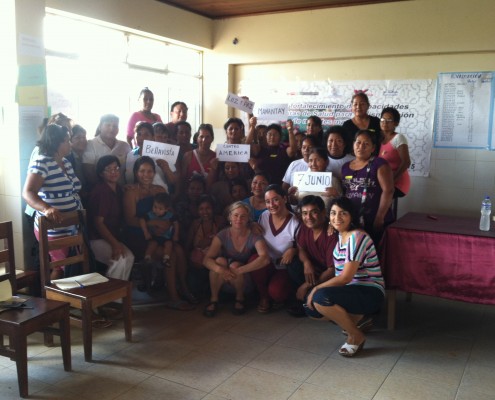We are working with an obstetrician in Pucallpas Peru, to create a model to train and supply community health workers (CHWs) based on national recommendations. Though the Peruvian Ministry of Health has well developed recommendations for CHWs, no other regions in Peru are developing programs due to lack of resources. This program specifically aims to lower maternal mortality in Uyucali, the region in Peru that currently has the highest maternal mortality rate. Uyacali has a maternal mortality rate of 250+:100,000 live births compared with the national average in Peru of 75:100,000. This mortality rate has increased sharply over the past three years due to migration of Indigenous (Shipibo) people from the jungle who are not seeking out medical care.
The CHWs will begin a program of identifying all of the women who need contraception, are pregnant and/or are experiencing domestic violence (44% of women here!) and try to encourage them to receive services in the clinic. If not, the obstetrias will go to the homes. They have developed forms for the CHWs, sectors of responsibility for each one, schedules for reporting and a schedule for training every month.
We are training and supplying 30 CHWs who will serve approximately 15,000 people in 6 impoverished, Shipibo villages. The woman who is coordinating this program is an obstetria who runs her own, Peruvian non-profit, so the accounting and structure for finances is established.
We are paying for materials, papers, training supplies and transportation for the CHWs. Since the obstetrias receive their salaries from the government and the CHWs are volunteers, we are not paying any wages. We will be able to measure outcomes with data from the Ministry of health. I think all in all this is a great opportunity for a cost effective, cooperative program that may improve outcomes in an extremely poor area. I hope that we can look at continuing this program for 5 years. While I have not made any promises beyond one year, if after 5 years we can demonstrate effect, this could be a model for other areas of Peru and for the government to continue funding.

Check out this article in the local press!!!!
/in UncategorizedClick on this link below to check out the article!
Livingston Enterprise Article
End of the Year Letter 2015
/in UncategorizedTo see what GMEF has been up to in late 2015 please check out our end of the year letter!
Newsletter Spring 2015
/in UncategorizedPhysician Training in Tupiza, Bolivia for Contraceptive Implants
/in Bolivia, Health Care Provider TrainingWater & Bathroom Projects in Tapaxa and Rio Blanco
/in UncategorizedTraining in Pulcallpas
/in Our Blog, PeruWe are working with an obstetrician in Pucallpas Peru, to create a model to train and supply community health workers (CHWs) based on national recommendations. Though the Peruvian Ministry of Health has well developed recommendations for CHWs, no other regions in Peru are developing programs due to lack of resources. This program specifically aims to lower maternal mortality in Uyucali, the region in Peru that currently has the highest maternal mortality rate. Uyacali has a maternal mortality rate of 250+:100,000 live births compared with the national average in Peru of 75:100,000. This mortality rate has increased sharply over the past three years due to migration of Indigenous (Shipibo) people from the jungle who are not seeking out medical care.
The CHWs will begin a program of identifying all of the women who need contraception, are pregnant and/or are experiencing domestic violence (44% of women here!) and try to encourage them to receive services in the clinic. If not, the obstetrias will go to the homes. They have developed forms for the CHWs, sectors of responsibility for each one, schedules for reporting and a schedule for training every month.
We are training and supplying 30 CHWs who will serve approximately 15,000 people in 6 impoverished, Shipibo villages. The woman who is coordinating this program is an obstetria who runs her own, Peruvian non-profit, so the accounting and structure for finances is established.
We are paying for materials, papers, training supplies and transportation for the CHWs. Since the obstetrias receive their salaries from the government and the CHWs are volunteers, we are not paying any wages. We will be able to measure outcomes with data from the Ministry of health. I think all in all this is a great opportunity for a cost effective, cooperative program that may improve outcomes in an extremely poor area. I hope that we can look at continuing this program for 5 years. While I have not made any promises beyond one year, if after 5 years we can demonstrate effect, this could be a model for other areas of Peru and for the government to continue funding.
On the road in Bolivia…
/in Bolivia, Our BlogOur GMEF Francisca Escalante (our associate) and Genevieve Reid on the road in Bolivia.
La Doctor y Francisca Escalante
Upcoming April 2015 Trip
/in Health Care Provider TrainingWe are planning a 3 week trip in April and will have three trainings, The first in Peru to train 50 Community Health Workers in the Jungle areas of Peru. The other traiings will be in Southern Bolivia where we will hae a midwife training refresher course as well as a training program to teach 20 doctors to use a new type of 3 year implantable contraception device. Read more about this safe contraception device being used worlwide.
Peruvian Ministry of Health Mid-wives in training
Bolivia Trip
/in Bolivia, Our Blog, SantitationWe had a successful trip to Bolivia this month, spending several days inspecting completed bathroom projects and creating partnerships with other communities for new bathroom and water projects.
An agreement was created for a community health worker training program in 12 villages to begin in the fall of 2014. Birth attendants needing restocking of birth supplies have been identified. They will receive more supplies and educational updates in the fall of 2014.